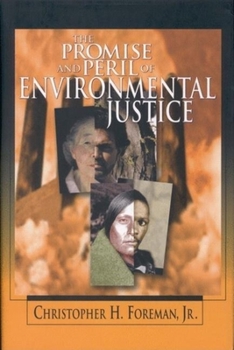The Promise and Peril of Environmental Justice
Select Format
Select Condition 
Book Overview
" Are we environmentally victimizing, perhaps even poisoning, our minority and low-income citizens? Proponents of ""environmental justice"" assert that environmental decisionmaking pays insufficient heed to the interests of those citizens, disproportionately burdens their neighborhoods with hazardous toxins, and perpetuates an insidious ""environmental racism."" In the first book-length critique of environmental justice advocacy, Christopher Foreman...
Format:Hardcover
Language:English
ISBN:0815728786
ISBN13:9780815728788
Release Date:August 1998
Publisher:Brookings Institution Press
Length:208 Pages
Weight:1.00 lbs.
Dimensions:0.8" x 6.3" x 9.3"
Customer Reviews
2 ratings
The book provides an outstanding analysis of EJ issues
Published by Thriftbooks.com User , 24 years ago
"The Promise and Peril of Environmental Justice" provides a brilliant analysis of the public policy setting of Environmental Justice. What I got out of the book is that environmental regulations are inherently flawed because public participation in facility permitting comes near the end of permitting process. Because of this, impoverished communities with fewer political resources feel helpless to affect the siting of industrial facilities. Activists use this feeling of helplessness, along with bogeyman of increased risk, to rally opposition to a given facility. However, as described in the book, the increased risk posed by such a facility is almost always inconsequential. The author argues that the Environmental Justice movement is not about decreasing risk or improving community health, but rather community empowerment. Additionally, the author suggests that quality of life in impoverished communities can be improved through participation in the economic development that is spawned by environmental regulations. An example of this would be community participation in brownfields projects.The book is formatted in a style of a graduate-level textbook, with all of the sources of the book properly documented. This format, however, does not detract from the book's analysis of the public policy issues associated with Environmental Justice. I enjoyed Foreman's writing style and thought some passages were especially well-written. I wish all of my textbooks would have been this compelling.As an environmental compliance professional at a highly visible facility, I never quite understood why certain residents were so hostile toward our facility, why the efforts of local activists were at times disjointed, or why regulators would subject themselves to seemingly unnecessary public meetings. This book clarifies the motivations of these various groups in dealing with controversial facilities. I would recommend this book to both environmental regulators and compliance personnel in the private sector. I believe that meaningful strategies for community involvement in environmental permitting can be crafted based on the analysis presented in this book.
The book provides an outstanding analysis of EJ issues
Published by Thriftbooks.com User , 25 years ago
"The Promise and Peril of Environmental Justice" provides a brilliant analysis of the public policy setting of Environmental Justice. What I got out of the book is that environmental regulations are inherently flawed because public participation in facility permitting comes near the end of permitting process. Because of this, impoverished communities with fewer political resources feel helpless to affect the siting of industrial facilities. Activists use this feeling of helplessness, along with bogeyman of increased risk, to rally opposition to a given facility. However, as described in the book, the increased risk posed by such a facility is almost always inconsequential. The author argues that the Environmental Justice movement is not about decreasing risk or improving community health, but rather community empowerment. Additionally, the author suggests that quality of life in impoverished communities can be improved through participation in the economic development that is spawned by environmental regulations. An example of this would be community participation in brownfields projects.The book is formatted in a style of a graduate-level textbook, with all of the sources of the book properly documented. This format, however, does not detract from the book's analysis of the public policy issues associated with Environmental Justice. I enjoyed Foreman's writing style and thought some passages were especially well-written. I wish all of my textbooks would have been this compelling.As an environmental compliance professional at a highly visible facility, I never quite understood why certain residents were so hostile toward our facility, why the efforts of local activists were at times disjointed, or why regulators would subject themselves to seemingly unnecessary public meetings. This book clarifies the motivations of these various groups in dealing with controversial facilities. I would recommend this book to both environmental regulators and compliance personnel in the private sector. I believe that meaningful strategies for community involvement in environmental permitting can be crafted based on the analysis presented in this book.





